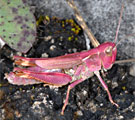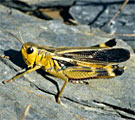Paracinema tricolor (Thunberg, 1815)
![Paracinema tricolor: Female (Camargue, Southern France, mid-October 2013) [N] Paracinema tricolor: Female (Camargue, Southern France, mid-October 2013) [N]](thumbs/acrididae/tricolor_im2013.jpg)
![Paracinema tricolor: Female (Camargue, Southern France, mid-October 2013). Such nice three-coloured individuals are not so common because the dorsal brown is often replaced by more green. [N] Paracinema tricolor: Female (Camargue, Southern France, mid-October 2013). Such nice three-coloured individuals are not so common because the dorsal brown is often replaced by more green. [N]](thumbs/acrididae/tricolor_2im2013.jpg)
![Paracinema tricolor: Female (Camargue, Southern France, mid-October 2013) [N] Paracinema tricolor: Female (Camargue, Southern France, mid-October 2013) [N]](thumbs/acrididae/tricolor_3im2013.jpg)
![Paracinema tricolor: Female (Camargue, Southern France, mid-October 2013) [N] Paracinema tricolor: Female (Camargue, Southern France, mid-October 2013) [N]](thumbs/acrididae/tricolor_4im2013.jpg)
![Paracinema tricolor: Male (Camargue, mid-October 2013) [N] Paracinema tricolor: Male (Camargue, mid-October 2013) [N]](thumbs/acrididae/tricolor_5im2013.jpg)
![Paracinema tricolor: Male (Camargue, mid-October 2013) [N] Paracinema tricolor: Male (Camargue, mid-October 2013) [N]](thumbs/acrididae/tricolor_6im2013.jpg)
![Paracinema tricolor: Male (Camargue, mid-October 2013) [N] Paracinema tricolor: Male (Camargue, mid-October 2013) [N]](thumbs/acrididae/tricolor_7im2013.jpg)
![Paracinema tricolor: Male (Camargue, mid-October 2013) [N] Paracinema tricolor: Male (Camargue, mid-October 2013) [N]](thumbs/acrididae/tricolor_8im2013.jpg)
![Paracinema tricolor: Male (Camargue, mid-October 2013) [N] Paracinema tricolor: Male (Camargue, mid-October 2013) [N]](thumbs/acrididae/tricolor_9im2013.jpg)
![Paracinema tricolor: Male (Camargue, mid-October 2013) [N] Paracinema tricolor: Male (Camargue, mid-October 2013) [N]](thumbs/acrididae/tricolor_10im2013.jpg)
![Paracinema tricolor: Habitat in the Camargue. Most of the more than 30 observed individuals were encountered on the short-grassy and seldom used field path between irrigated rice field and reed edge. [N] Paracinema tricolor: Habitat in the Camargue. Most of the more than 30 observed individuals were encountered on the short-grassy and seldom used field path between irrigated rice field and reed edge. [N]](thumbs/acrididae/tricolor_h2013.jpg)
![Paracinema tricolor: Habitat in the Camargue in mid-October 2013 [N] Paracinema tricolor: Habitat in the Camargue in mid-October 2013 [N]](thumbs/acrididae/tricolor_2h2013.jpg)
![Paracinema tricolor: Habitat in the Camargue in mid-October 2013 (most individuals in the foreground) [N] Paracinema tricolor: Habitat in the Camargue in mid-October 2013 (most individuals in the foreground) [N]](thumbs/acrididae/tricolor_3h2013.jpg)
![Paracinema tricolor: Habitat with only low density (Camargue, October 2013) [N] Paracinema tricolor: Habitat with only low density (Camargue, October 2013) [N]](thumbs/acrididae/tricolor_4h2013.jpg)
Nutrition:
The species feeds primarily on grasses.
Habitat:
Paracinema tricolor inhabits warm lowland wetlands as grassy watersides, extensively managed rice fields with broad grass and reed edges or wet depressions. Important is enough humidity also in mid summer. I observed Paracinema tricolor in the southern French Camargue most common at low-growing grassy edges of rice fields which were interspersed with broad reed ditches etc. Paracinema tricolor can be compared with the Central European Stetophyma grossum which also copes best with a mix of mowed, low-growing and unmowed, higher growing and very wet patches.
Life cycle:
The adults mostly occur between July and October or November. They are excellent flyers and difficult to photograph in hot weather. In mid-October however, I did not encounter severe problems in cooler weather. The eggs hibernate in the soil or perhaps also the litter and survive winterly flooding.
Endangerment factors:
Paracinema tricolor is still quite widespread in Mediterranean wetlands, but suffers severe habitat losses especially near the coast due to agricultural intensification and overbuilding (urban sprawl, traffic, industry, tourism).
Remarks:
Paracinema tricolor occurs in several subspecies (Europe: ssp. bisignata) from Madagascar and central Africa to Southern Europe, Arabia and Western Asia (Turkey). In Europe it is observed to the north to the Italian Po Valley and Central France. It formerly occurred in the vicinity of Geneva.


